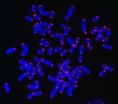"Our results are important because there are an estimated 400,000 individuals affected by multiple sclerosis in the United States, some of whom experience symptoms that limit their quality of life in several ways. For many, it can be quite debilitating," explained Hector Ferral, M.D., an interventional radiologist at NorthShore University HealthSystem in Evanston, Ill. "These early results show that performing angioplasty on azygos and jugular vein lesions may have a positive impact on the symptoms of those individuals with MS and also could be an effective palliative treatment geared toward improving their quality of life," added Ferral, the study's lead investigator.
"Our experience showed that 95 percent of the individuals we evaluated had venous obstructions, supporting the concept that venous lesions are common in individuals with multiple sclerosis," said Ferral. "Based on follow-up that included ultrasound one week post procedure and clinic visits every three months, our results showed that people who have this treatment are not exposed to fatal risks. It is our belief that portraying venous angioplasty of the azygos and jugular veins as a high-risk procedure is a widespread misconception that needs to be addressed and corrected," he noted. "In addition to these significant safety findings, we noted that angioplasty provided symptomatic benefit in 55 percent of the individuals we treated," said Ferral.
MS is classified as primary progressive, which means a gradually progressive disease without remission; relapsing remitting, which demonstrates acute attacks with intervals of slow improvements in symptoms; or secondary progressive, where a disease that was once relapsing remitting, is now slowly progressing.
This retrospective review examined results of 105 procedures performed in 94 individuals with MS (age range, 26-67 years old; 35 men, 59 women). This study's subgroups included 50 percent relapsing remitting, 39 percent secondary progressive, 6.4 percent primary progressive and 4.2 percent unknown. Jugular and azygos veins were evaluated with selective venography (imaging of veins after injection with a contrast dye) and intravascular ultrasound (a special imaging process that allows the physician to see from inside the blood vessels). Angioplasty was performed if the imaging confirmed reflux, a condition where valves become weak and don't close properly, allowing blood to flow backward, or a greater than 50 percent decrease in the vessel's diameter. If necessary, stents were then used to treat nonresponsive lesions or blockages. These individuals were given blood-thinning medications for six weeks after the treatment.
Ferral's team reported symptomatic improvement in 55 percent of the individuals treated, and 38 percent reported no improvement. Seven percent of patients did not comply with their follow-up visits and were considered to be lost to follow-up.
Close to 60 percent of those with relapsing remitting MS reported improvement in symptoms, the highest of all the subgroups in this study.
"These important results revealed that, for people with multiple sclerosis who experience debilitating symptoms, minimally invasive interventional radiology treatments can be an effective, palliative treatment that also may improve their quality of life," said Ferral.
"As interventional radiologists, our biggest challenge is to bring to the attention of other specialists, especially those physicians specialized in multiple sclerosis, the evidence that venous lesions, often classified as chronic cerebrospinal venous insufficiency or CCSVI, may be a true entity that deserves further attention and serious research," Ferral explained.
The Society of Interventional Radiology stresses the importance for MS patients to continue an on-going dialogue with their neurologists to discuss their treatment care.
In 2011, members of a Society of Interventional Radiology Foundation's Research Consensus Panel noted that evaluating people with multiple sclerosis who have narrowed jugular and azygos veins—and examining the value of widening those veins with angioplasty—warranted careful, well-designed research. The multidisciplinary panel indicated that the "mandatory goal" should be through large-scale, pivotal multicenter trials to explore CCSVI.
###
Interventional radiologists are vascular specialists who pioneered venous angioplasty and stenting and are highly qualified to perform such treatments when appropriately indicated. IR physicians have the expertise in the endovascular techniques central to this novel treatment for MS.
More information about the Society of Interventional Radiology, interventional radiologists and minimally invasive treatments can be found online at www.SIRweb.org.
Abstract 49: "Clinical Experience in the Management of CCSVI: Single-center Experience," H. Ferral, G. Behrens, Y. Tumer, T. Souman, radiology, Rush University Medical Center, Chicago, Ill., SIR 37th Annual Scientific Meeting, March 24-29, 2012. This abstract can be found online at www.JVIR.org.
About the Society of Interventional Radiology
Interventional radiologists are physicians who specialize in minimally invasive, targeted treatments. They offer the most in-depth knowledge of the least invasive treatments available coupled with diagnostic and clinical experience across all specialties. They use X-ray, MRI and other imaging to advance a catheter in the body, such as in an artery, to treat at the source of the disease internally. As the inventors of angioplasty and the catheter-delivered stent, which were first used in the legs to treat peripheral arterial disease, interventional radiologists pioneered minimally invasive modern medicine.
Today, interventional oncology is a growing specialty area of interventional radiology. Interventional radiologists can deliver treatments for cancer directly to the tumor without significant side effects or damage to nearby normal tissue.
Many conditions that once required surgery can be treated less invasively by interventional radiologists. Interventional radiology treatments offer less risk, less pain and less recovery time compared to open surgery. Visit www.SIRweb.org.
The Society of Interventional Radiology is holding its 37th Annual Scientific Meeting March 24-29 at Moscone Center, San Francisco, Calif. The theme of the meeting is "IR Evidence," chosen to reflect interventional radiology's gathering, presenting and discussing results of care-changing investigations.
END

